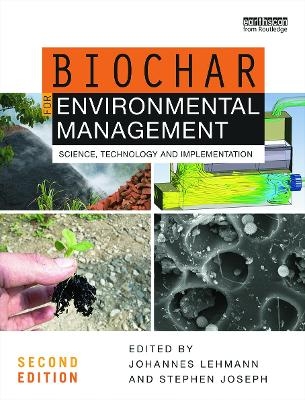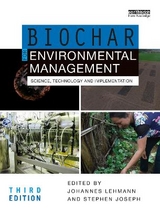
Biochar for Environmental Management
Routledge (Verlag)
978-0-415-70415-1 (ISBN)
- Titel erscheint in neuer Auflage
- Artikel merken
Biochar is the carbon-rich product which occurs when biomass (such as wood, manure or crop residues) is heated in a closed container with little or no available air. It can be used to improve agriculture and the environment in several ways, and its persistence in soil and nutrient-retention properties make it an ideal soil amendment to increase crop yields. In addition to this, biochar sequestration, in combination with sustainable biomass production, can be carbon-negative and therefore used to actively remove carbon dioxide from the atmosphere, with potentially major implications for mitigation of climate change. Biochar production can also be combined with bioenergy production through the use of the gases that are given off in the pyrolysis process.
The first edition of this book, published in 2009, was the definitive work reviewing the expanding research literature on this topic. Since then, the rate of research activity has increased at least ten-fold, and biochar products are now commercially available as soil amendments. This second edition includes not only substantially updated chapters, but also additional chapters: on environmental risk assessment; on new uses of biochar in composting and potting mixes; a new and controversial field of studying the effects of biochar on soil carbon cycles; on traditional use with very recent discoveries that biochar was used not only in the Amazon but also in Africa and Asia; on changes in water availability and soil water dynamics; and on sustainability and certification. The book therefore continues to represent the most comprehensive compilation of current knowledge on all aspects of biochar.
Johannes Lehmann is professor of soil biogeochemistry and soil fertility management at Cornell University, USA, Co-founder and Chair of the Board of the International Biochar Initiative, member of the U.S. Departments of Agriculture and Energy Biomass R&D committee and editor-in-chief of Nutrient Cycling in Agroecosystems Stephen Joseph is a visiting professor in the School of Materials Science and Engineering at the University of New South Wales, Australia, and Co-founder of the International Biochar Initiative.
1. Biochar for Environmental Management: An Introduction Johannes Lehmann and Stephen Joseph 2. Traditional Use of Biochar Katja Wiedner and Bruno Glaser 3. Fundamentals of Biochar Production Robert Brown, Bernardo del Campo, Akwasi A. Boateng, Manuel Garcia-Perez and Ondřej Mašek 4. Biochar Production Technology Akwasi A. Boateng, Manuel Garcia-Perez, Ondřej Mašek, Robert Brown and Bernardo del Campo 5. Characteristics of Biochar: Physical and Structural Properties Chee H. Chia, Adriana Downie and Paul Munroe 6. Characteristics of Biochar: Macro-molecular Properties Markus Kleber, William Hockaday and Peter S. Nico 7. Biochar Elemental Composition and Factors Influencing Nutrient Retention James A. Ippolito, Kurt A. Spokas, Jeffrey. M. Novak, Rick. D. Lentz and Keri B. Cantrell 8. A Biochar Classification System and Associated Test Methods Marta Camps-Arbestain, James E. Amonette, Balwant Singh, Tao Wang and Hans Peter Schmidt 9. Evolution of Biochar Properties in Soil Joseph J. Pignatello, Minori Uchimiya, Samuel Abiven and Michael W.I. Schmidt 10. Persistence of Biochar in Soil Johannes Lehmann, Samuel Abiven, Markus Kleber, Genxing Pan, BP Singh, Saran Sohi and Andy Zimmerman 11. Movement of Biochar in the Environment Cornelia Rumpel, Jens Leifeld, Cristina Santin and Stefan Doerr 12. Biochar Effects on Crop Yield Simon Jeffery, Diego Abalos, Kurt Spokas and Frank G.A. Verheijen 13. Biochar Effects on the Abundance, Activity and Diversity of the Soil Biota Janice E. Thies, Matthias C. Rillig and Ellen R. Graber 14. Biochar Effects on Plant Ecophysiology Claudia Kammann and Ellen Graber 15. Biochar Effects on Soil Nutrient Transformations Thomas H. DeLuca, Michael J.Gundale, M. Derek MacKenzie and Davey L. Jones 16. Priming Effects in Biochar-amended Soils: Implications of Biochar-soil Organic Matter Interactions for Carbon Storage Thea Whitman, Bhupinder Pal Singh and Andrew Zimmerman 17. Biochar Effects on Nitrous Oxide and Methane Emissions from Soil Lukas Van Zwieten, Claudia Kammann, MariaLuz Cayuela, Bhupinder Pal Singh, Stephen Joseph, Stephen Kimber, Scott Donne, Tim Clough and Kurt Spokas 18. Biochar Effects on Nutrient Leaching David Laird and Natalia Rogovska 19. Biochar Effects on Soil Hydrology Caroline A. Masiello, Brandon Dugan, Catherine E. Brewer, Kurt Spokas, Jeffrey M. Novak, Zuolin Liu and Giovambattista Sorrenti 20. Biochar and Heavy Metals Luke Beesley, Eduardo Moreno, Guido Fellet, Leonidas Carrijo and Tom Sizmur 21. Polycyclic Aromatic Hydrocarbons and Polychlorinated Aromatic Compounds in Biochar Thomas D. Bucheli, Isabel Hilber and Hans-Peter Schmidt 22. Sorption and Remediation of Organic Compounds in Soils and Sediments by (Activated) Biochar Sarah E. Hale, Gerard Cornelissen and David Werner 23. Biochar and Retention/Efficacy of Pesticides Ellen R. Graber and Rai Kookana 24. Test Procedures for Biochar Analysis in Soils Michael Bird 25. Biochar as an Additive to Compost and Growing Media Christoph Steiner, Miguel A. Sánchez-Monedero and Claudia Kammann 26. Biochar Systems and System Fit Saran Sohi, John McDonagh, Jeff Novak, Weixiang Wu and Luciana-Maria Miu 27. Biochar, Carbon Accounting and Climate Change Annette Cowie, Dominic Woolf, John Gaunt, Miguel Brandão and Ruy Anaya de la Rosa 28. Biochar Sustainability and Certification Frank G.A. Verheijen, Ana Catarina Bastos, Hans Peter Schmidt, Miguel Brandão and Simon Jeffery 29. Economic Evaluation of Biochar Systems: Current Evidence and Challenges Simon Shackley, Abbie Clare, Stephen Joseph, Bruce McCarl and Hans-Peter Schmidt 30. Socio-economic Feasibility, Implementation and Evaluation of Small Scale Biochar Projects Stephen Joseph, Mai Lan Anh, Abbie Clare and Simon Shackley 31. Commercialization of the Biochar Industry Michael Sesko, David Shearer and Gregory Stangl
| Erscheint lt. Verlag | 19.2.2015 |
|---|---|
| Zusatzinfo | 84 Tables, black and white; 28 Line drawings, color; 181 Line drawings, black and white; 5 Halftones, color; 22 Halftones, black and white; 33 Illustrations, color; 200 Illustrations, black and white |
| Verlagsort | London |
| Sprache | englisch |
| Maße | 189 x 246 mm |
| Gewicht | 2222 g |
| Themenwelt | Naturwissenschaften ► Biologie ► Ökologie / Naturschutz |
| Naturwissenschaften ► Geowissenschaften ► Geologie | |
| Technik ► Elektrotechnik / Energietechnik | |
| Technik ► Umwelttechnik / Biotechnologie | |
| Weitere Fachgebiete ► Land- / Forstwirtschaft / Fischerei | |
| ISBN-10 | 0-415-70415-4 / 0415704154 |
| ISBN-13 | 978-0-415-70415-1 / 9780415704151 |
| Zustand | Neuware |
| Informationen gemäß Produktsicherheitsverordnung (GPSR) | |
| Haben Sie eine Frage zum Produkt? |
aus dem Bereich



